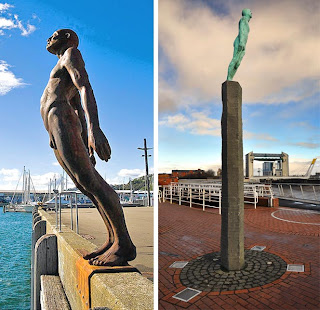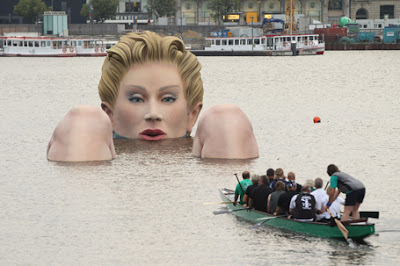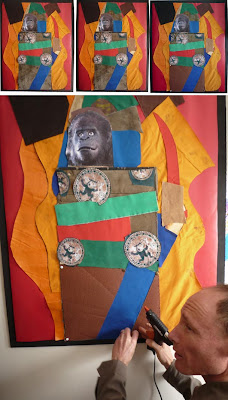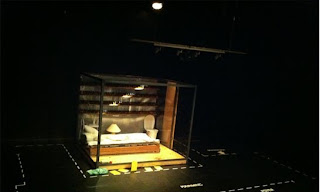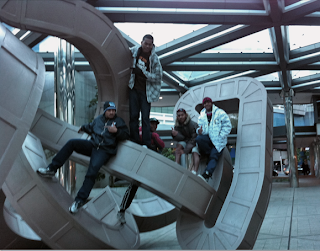Friday, September 30, 2011
Lookalike
Posted by
jim and Mary
at
11:58 AM
![]()
![]()
Labels: lookalike, public sculpture
Mything the point
Posted by
jim and Mary
at
6:59 AM
![]()
![]()
Labels: art museum
Thursday, September 29, 2011
One day at the public sculpture committee
Posted by
jim and Mary
at
6:59 AM
![]()
![]()
Labels: public sculpture
Wednesday, September 28, 2011
OTN goes viral
Death in Venice
Posted by
jim and Mary
at
6:43 AM
![]()
![]()
Labels: cnz venice, media
Tuesday, September 27, 2011
Bent
Posted by
jim and Mary
at
6:59 AM
![]()
![]()
Labels: public sculpture
Monday, September 26, 2011
The best of the boosters: final edition
So let's hear it one last time for art museum marketing departments putting it out for art:
Saturday, September 24, 2011
Lookalike
Friday, September 23, 2011
Second life
Image: the end of the line, a virtual visitor gets to be present with Marina Abramovic.
You can see a week of the game site download stats here
Posted by
jim and Mary
at
11:45 AM
![]()
![]()
Labels: games, performance
Thoughtless
Posted by
jim and Mary
at
6:59 AM
![]()
![]()
Labels: controversy, public sculpture
Thursday, September 22, 2011
Never say never
Wednesday, September 21, 2011
A crate exhibition
Posted by
jim and Mary
at
11:55 AM
![]()
![]()
Labels: Christchurch quake
Shape lifter
Posted by
jim and Mary
at
6:58 AM
![]()
![]()
Labels: art and fashion, serra, style
Tuesday, September 20, 2011
Resting between engagements
Posted by
jim and Mary
at
11:57 AM
![]()
![]()
Labels: peryer, photographers at play
By the numbers
We have put all the comments following Andrew Clifford's question over on OTN Stuff, You can follow them here or on the OTN Facebook page.
Posted by
jim and Mary
at
6:59 AM
![]()
![]()
Labels: art museum
Monday, September 19, 2011
Spring pruning
Posted by
jim and Mary
at
6:59 AM
![]()
![]()
Labels: dealers, melbourne art fair, prunes
Saturday, September 17, 2011
David in adland: volume 2
Posted by
jim and Mary
at
6:59 AM
![]()
![]()
Labels: art in adland
Friday, September 16, 2011
Two stories about drawing
From a TED presentation by Ken Robinson
Howard Ikemoto
Present
Posted by
jim and Mary
at
6:59 AM
![]()
![]()
Labels: fun and games, games, performance
Thursday, September 15, 2011
Rohan Rohan la la la
Later: Also forgot to mention that the real Rohan has an exhibition on at Hamish McKay Gallery in Wellington right this minute.
Posted by
jim and Mary
at
11:59 AM
![]()
![]()
Labels: exhbitions, lookalike
The living dead
Wednesday, September 14, 2011
Dennis Knight Turner 1924-2011
Give me your tired, your poor, your huddled masses ....
Image; NZ dealer awaits an approach by the Melbourne Art Fair
Posted by
jim and Mary
at
6:59 AM
![]()
![]()
Labels: art fair, dealer gallery
Tuesday, September 13, 2011
Lighten up
One of the big challenges in collecting contemporary art is maintaining and replacing obsolete technology. A lot of artists want to use the nostalgia and sense of authenticity that often comes with out of date equipment. In New Zealand et al is an obvious example and so too is Simon Denny. If you purchased one of Ronnie van Hout’s green screen monitor works of the late 1990s, better start looking for replacements as they are already very difficult to source. And don't even talk about works that include the incandescent bulbs that are already banned in Europe.
Then there are the neon tubes that American Dan Flavin favoured for most of his work. Already there are intellectual and legal arguments over whether or not old tubes can be replaced by new ones with slightly different colour temperatures. You can read a fascinating account of the Flavin problem here.
However, as interesting as all this is, it is just a thinly-veiled excuse to show you a Japanese guy running through 70 neon tubes.
Monday, September 12, 2011
In and out of focus
Posted by
jim and Mary
at
6:59 AM
![]()
![]()
Labels: curators, focus group, Te papa
Saturday, September 10, 2011
Saturday at the flicks
You do have to ask yourself sometimes, "How the hell did all this art criticism get underway?"
Thanks again, again P
Friday, September 09, 2011
Plinth charming
Posted by
jim and Mary
at
11:57 AM
![]()
![]()
Labels: auckland art gallery, sculpture
Mag lights
Thursday, September 08, 2011
Card sharps
Who goes there?
Posted by
jim and Mary
at
6:57 AM
![]()
![]()
Labels: auckland art gallery, audience
Wednesday, September 07, 2011
Outer space
Tuesday, September 06, 2011
Spam
Monday, September 05, 2011
The real thing
Posted by
jim and Mary
at
6:55 AM
![]()
![]()
Labels: art museum, auckland art gallery, curators, exhbitions
Saturday, September 03, 2011
Friday, September 02, 2011
Pining for Totora
Thursday, September 01, 2011
Advice to collectors
Posted by
jim and Mary
at
11:03 AM
![]()
![]()
Labels: advice to collectors, quote
Label Land
Listed below are descriptions of artists taken off a bunch of labels at a group show. The challenge is to attach the correct label to each of the artists. Off you go, answers below.
Posted by
jim and Mary
at
6:59 AM
![]()
![]()
Labels: art museum, label land, labels
